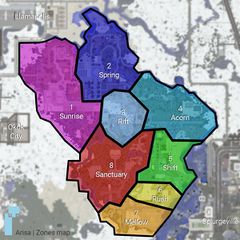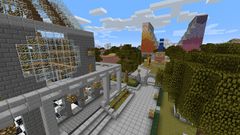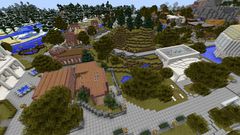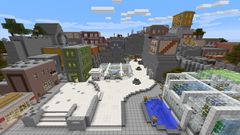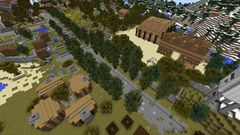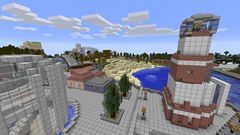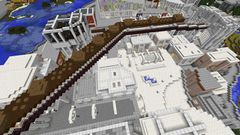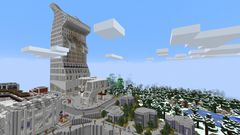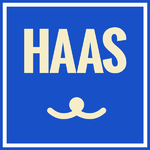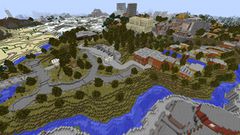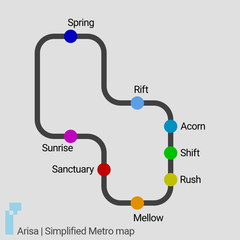Arisa
| Arisa | |
|---|---|
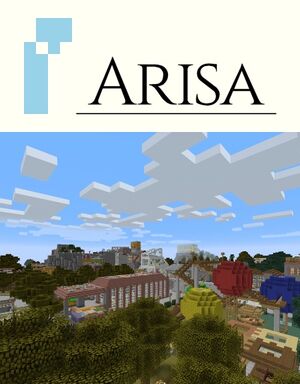 | |
| Officials | |
| Mayor | kekkomatic |
| Transit | |
| Bus | Arrivé Bus Lines 820 Arrivé Bus Lines 821 |
| Roadways | SR-103 |
| Other transit | Eristheeagle Memorial Municipal Airport (via Arrivé Bus Lines 821 to Llamapolis) DS1 Vanadium Direct Services |
| Facts and figures | |
| Coordinates | 2672, 74, 1736 |
| Founded | July 20, 2012 |
| Rank | Premier |
| World | Old |
Arisa is a Premier city built and owned by kekkomatic. It is the first and only city on the Old World to receive an honorary rank of Premier.
As of October 2015, its status is "completed, under maintenance".
Background
The project started in late July 2012, with the objective of creating a town where intuitiveness would get a priority over aesthetics. For this reason, the concept was expanded to include a set of rules, summarized into 3 categories:
- Guides and indications: Written signs are hard to read from a distance and stand in the way of user experience, people would need to stop just to read the sign. Enchanted item frames are used for very limited purposes, in places where it is natural but not necessary to stop: in front of premises, in transit systems, in billboards. Written signs are still used though for official communications.
- Function of blocks: Although commonplace to use some block categories to emulate, in form, objects easily recognizable in real life, they should still serve the purpose they are logically meant to have. For example: it is acceptable to use strong materials like stone and iron for support beams and walls, instead of wool. Exceptions exist purely for aesthetic reasons, like stair blocks for roofs and pressure plates on fences for tables; however, stairs as chairs are absent, as there is no way to make a player sit easily in vanilla Minecraft.
- Architecture and landscape: Creations do not need to be limited to strict rules, but careful consideration should be given to proportions. In large buildings, it is important to include pillars and support beams, just like in real life. The structures should blend in with the surrounding natural formations, and altitude of the original land should be respected as much as possible.
Concept
Arisa is based upon the rules dictated by the New Urbanism movement, with extensive walkable, easily accessible areas and high respect for the surrounding environment. The number 8 is also a foundation for management and stylistic decisions: 8 districts; a building with an entrance marked by 8 trees.
Geography
Arisa, although operated independently, is part of a cluster of cities surrounding Midcity (dynmap). It is located on the east side and neighbors Splurgeville on the east, Nanthaven on the south, and Llamapolis on the north. The building ground underwent a deep transformation, with every sand and sandstone block replaced by grass—apart from selected areas—in the west, north, and east districts, and by stone in the urban south-east districts.
Topography
The area is, for the most part, reclaimed desert land, with a small, fragmented hill roughly equidistant from the city borders. For this reason, Arisa has very little variance in altitude, but does feature two major bodies of water: the looping river surrounding Sanctuary, the island in the middle; the Midcity river, which acts as a border on the north side, and flows into the swamp on the east.
Architecture
As expectable from a traditional city, Arisa features a number of buildings which refer to different art movements. Brutalism as well as modernism are frequently displayed (a main example is the "stair condos"), but neoclassicism also plays a smaller part. Styles are often contained within districts, as well as the choice of building materials: stone and cold colored clay are used in residential areas, wood and earth-colored clay for farms, iron and glass in urban environments. Buildings are often small and segmented, with little external ornaments, and do not extend for more than 2 floors (a clear exception is the HAAS, a high-rise located in the south-east border).
Districts
The city is divided into 8 districts called "zones", each with their own style and purpose. A color is associated with them, reflected in the metro station logos.
Zone 1 - Sunrise
Located on the west side, Sunrise is the only district connected to an external road, SR-103. A wide entrance, outlined by trees, leads to a park which hosts the Information Center, a moon-shaped building containing the latest development news and information for guests and citizens, and the Guestbook House. The park also acts as a hub for the library on the north, and Station 1 of Arisa Metro on the south. On an elevated level, the Stair Condos, a housing complex made of two identical, mirrored 7-storey buildings. On the extreme south, the Arisa Resource Storage Edifice, a manually operated item dispenser, marks the beginning of the "dry boardwalk", populated by restaurants, clubs, bars and a museum. Looking north, a small amusement park features a rollercoaster and some noteblock games, and a red brick farm separates Sunrise from the Arts Center, located in zone 2. Looking south, 3 houses face the looping river, isolated from the rest of the city.
Sunrise, as well as the surrounding districts, does not have roads, relying instead on broad, stone slab walkways. The abundance of shops and apartments makes it a perfect place for living independently without travelling long distances, if it were based in real life. However, given the scarcity of detached housing, it is not suitable for individuals seeking a more private experience.
Zone 2 - Spring
This district is primarily residential and takes much of the northern region. The Arisa Arts Center, a modern multi-storey structure with massive, sloped glass ceilings, is home to a few works made by other players. Right beside it, a raised restaurant peeks out of a shallow square pool and a stair entrance leads to a minimall and metro Station 2. On the east, a group of houses stand on the side of a walkable path that provides direct access to zone 4. On the north side, another small residential area comprised of large brick houses surround an underground planetarium. A quartz building, with architecture reminiscent of a country club, provides a lounge and private rooms, and acts as a gate to a river beach.
The closest real-life match to Spring is a suburb, with a relative proximity to shops and other places of interest as its only difference.
Zone 3 - Rift
Built on multiple levels and in the middle of the city, Rift is considered by many to be the old town. Its most visible feature is the two hills, divided by a square, right above metro Station 3; also underground a bookstore and a steakhouse with dining area inside a ravine. Massive stone brick walls made of nested and merged right square prisms contain much of the north hill; a mostly straight walkway surrounded by small shops, houses, and a place of cult with annexed library, leads to another square on the top and two bridges supported by quartz pillars. In contrast, the south hill is predominantly residential, facing the looping river, with bigger houses and twisted walkways. A greenhouse stands at the foot of the hill on the west side; moving east, a few wood houses and a small creative studio blend into the natural environment, and a uCars-compatible road connects the other districts.
Zone 4 - Acorn
Acorn constitutes the rural part of Arisa. Partially hidden by buildings, trees and a sunflower field, in a depressed area, a series of farms and houses made of wood and earth-colored clay occupy the north side. The cobblestone road from zone 3, enclosed by tall cypresses, extends east all the way on a straight line, where a gated animal shelter is located. Inside, a horse stable that can hold up to 7 horses; a large mixed barn with dedicated areas for sheep, pigs, cows and chickens; and the old bus #3 from the Spawn City depot, broken and sitting in the courtyard. On the other side of the road, an art installation and a wheat farm, built on a slope and sharing two water reservoirs. Much of the north-east border is delimited by trees, which separate the city from the adjacent snow biome.
Aside from Sanctuary, this area marks the last of the four "natural" zones. Unlike Sunrise, Spring and Rift, Acorn is suitable for people who want to live isolated from city life. Like a typical countryside, artificial permanent lighting is minimal and insufficient, parts of the road are broken, and irregular gravel paths are often the only way to reach a destination.
Zone 5 - Shift
The area incorporates rural and urban elements and acts as a transitional zone. Right beside Station 4, an iron structure resembling a water tower plays the first notes of Gymnopédie No. 1, when a button is pressed on the bottom floor. On the east coast facing the Splurgeville swamp, a series of sandstone huts form the Bread Quarters. Loosely inspired by middle-eastern villages, they were created with the intent of providing a space to store wheat from the farms in zone 4 and making bread. However, since they lack crafting tables, the huts are not suitable for breadmaking. Detached houses cover most of the west coast, with a clear view of the looping river and zone 8. On the side of a road with a palm tree median, a stairway leads to metro Station 5. Moving south, the road splits in two, where on the right a gated community called Daner features apartment buildings and specialized stores. The other street is connected to zone 6 and brings access to other shops and a grocery store, a large square with a lighthouse, and the east end of Arisa Shuttle.
Shift is noted for its lack of areas dedicated to leisure. On the other side, the abundance of commercial space makes it an important part of the city, especially given the gap created by rural zone 4: most of the shopping needs can be satisfied without travelling all the way to zone 1. Shift is one of the two zones (along with Mellow) to have all 4 transport infrastructures: pedestrian, road, metro, and shuttle.
Zone 6 - Rush
In direct contrast with zone 5, Rush is mostly populated by stores and entertainment venues. On the east side, a number of businesses such as a gift shop, restaurants, and a clothing store called "The Grind" (also located in Marblegate) are part of a wide stone promenade. At the south end stands Sedna, a small recording studio publicly available, with a dedicated floor for redstone wiring. Behind the promenade, Groove Street contains a music store, a radio station, a music club, and the Vertigo disco, featuring a semi-automatic lighting system that shuts off in the morning. Also nearby, a uFuel station allows players to buy and sell fuel in increments of 8 and 2 units, respectively. On the west, another street leads to a quartz square, surrounded by a wellness center, a pub, and a few houses. In the middle of the square, underground, metro Station 6 and a minimall provide transport and other shopping opportunities. High above, the shuttle railway connects zone 5 and 7.
Zone 7 - Mellow
Mellow takes up the south border. A high-rise called High Altitude Activity Space (HAAS) contains shops, a TV studio, a hotel and a restaurant. Right next to it, the Flowtwister, a building in the shape of a Möbius strip, serves as an office-less town hall, with information books, credits and thank you notes, and a wide overlook on the second floor. Right underneath the town hall, there is metro Station 7 and a minimall. Across the street, a small recording studio, Luna, is open to players. On the side, the west end of Arisa Shuttle connects this zone to Shift. The street curves left to end and fade into wilderness; nearby a lower area is populated by houses in style inspired by Evella, and a walkway leads to a bridge.
If they were to be compared to a real-life district, Mellow and Rush would be areas best suited for tourists, because of the hotel and a large number of entertainment venues. In addition, Mellow is one of the two zones (along with Shift) to have all 4 transport infrastructures: pedestrian, road, metro, and shuttle. Mellow marks the last of the "modern" zones.
HAAS
The High Altitude Activity Space is a commercial high-rise located on the south-east corner of the city. Standing on a 1600 m² square base, it is the tallest building in Arisa at 136 m high. It is noted for resembling a rabbit and, because of its unconventional shape, some of its floors have various heights. The building is supported by 8 iron columns placed on the sides and is divided into 4 main areas:
- The lobby, which makes the first two floors, contains an open lounge, a few stores, and an audition room for Arisa Studios;
- Arisa Studio Sol has, on its first floor, a circular balcony overlooking the lobby, and two entrances to the studio: one for the audience through an elevator; the other for cast and crew, with a few dressing rooms and a red elevator that goes up to the studio on one level and to the writers' room on the top floor. Unlike Sedna and Luna, Studio Sol is not a freebuild area, but it is available to players under permission from the mayor. The main elevator goes from the first floor to the studio; to access the other floors, two elevators are located on the north side of the building;
- Spectrum Hotel, which occupies 5 floors accessible through an internal elevator and staircase, offers 32 rooms. The 5th floor also contains the first two observation points (the "rabbit paws");
- The iwi Restaurant is an experimental commercial space, with no floors and loosely supported wooden platforms, some of them built on a slope. The two observation points at the top (the "rabbit ears") are only accessible by walking through all the platforms, and extend a few meters over the building base.
Zone 8 - Sanctuary
Sanctuary is an island-park surrounded by a ring of water called Looping River. It can only be accessed by walking through a bridge connected to the residential area in zone 7. The island contains a large number of handmade trees and little artificial lighting buried into the ground. A cobblestone road branches out from the bridge to various natural formations such as slopes and a pond shadowed by tall trees. The road expands further north to a wide stone platform. From there, a staircase leads up a hill where the Institute is located, a sandstone villa with a ballroom on the second floor. At the foot of the hill on the east side, a series of orange and yellow houses and stone paths are part of the Sunset Resort, where people would usually go on vacation. On the west side, The Condor Club—the first "airport lounge without the airport"—is a nightclub with a semi-automatic chasing light system that shuts off in the morning; because of insufficient sunlight that enters the recessed windows, the lights can be forced on, continuously, at all hours. The looping river is interrupted by a snow biome patch and a cluster of trees embedded in the ice, but a tunnel passing through the island allows players to navigate all the way to the other side.
Underneath Sanctuary, Station 8 completes the metro system. Made entirely of quartz, it is the biggest station and the only one with a discrete arrival bay.
Life in Arisa
Despite being located in the Old World, Arisa is frequently visited by a growing number of players.
Housing
The city has more than 130 houses and apartments, in styles ranging from modern to rustic. All furnished, they are ready for players to own and decorate—with some limitations—under permission from the mayor. Once they become citizens of Arisa, players are given a book of guidelines as an add-on to the MRT server rules. The book is usually updated after every server upgrade and is available in both the Information Center in zone 1 and the town hall in zone 7.
Shopping
Arisa is one of the few towns on the MRT not to have any franchise, relying instead on generic stores and original businesses not available elsewhere. A few exceptions are The Grind clothing store, originally built in Marblegate; the O-dot bookstore (stylized "O.") located in Evella, Laclede, and other locations; The Orange Pinecone giftshop in Elecna Bay; and a joke store that sells only cacti. Initially called Just Cactus, it was developed around the idea that franchises on the MRT often lose value once they get copied and pasted in many places, and that a handmade, shoddily-built cactus shop would be just as successful as a detailed but worldedited one, based solely on high demand for ready-made buildings in new towns. Cactus shops usually have a square base, birch wood floor with lighting hidden by dark green carpet, walls made of lime and green stained clay in vertical lines, and cactus pots placed on slabs. The front sign is either missing or contains a random fact, for instance, "Butterflies have taste buds on their feet".
Stores in Arisa, especially clothing stores, sell items with custom names, and sometimes are part of a chain (an example would be the A-way travel agency).
Entertainment
The city is a popular stage for a number of games played on the MRT server: it was featured in The Mole seasons 2, 3, 6, 7 and as Pit Stop in the second, third, and seventh season of The Amazing Race. It was visited not as a Pit Stop in the ninth season. As of June 2018, Arisa has not hosted any other show.
Three recording studios, two open to the players and one available under request, have been built in zone 6 and 7. In zone 2, an underground planetarium can be used as a small stage.
On October 8-10-11 2015, to celebrate the end of development in Arisa, kekkomatic hosted a tour of the city. At the end of the tour, the participants took a group photo at the open stage in the Sunset Resort.
Parks and recreation
Arisa is one of the greenest cities on the MRT server, with more than 40% of land designated to open parks. Trees are generated by the game, mainly oaks, or created from scratch, usually resembling cypresses and elms. Most prominently, Sanctuary is an island-park with minimal architecture and rich flora.
Infrastructure
Metro
A subway system with 8 stops loops around the city both ways. Every zone in Arisa has its own station, each with a different style, often taking clues from the surrounding architecture. All stations have at least one stairway located either outside (such as in a square or next to a sidewalk) or inside an indoor commercial area. Stations in zones 1, 2, 3, 6, and 7 also have a few stores inside, referred in group as "minimall", despite not being actual strip malls.
The stations have a single point of departure and arrival: the bay receives a "go" signal whenever a cart is approaching. A button placed on the side can either start a minecart or call one from the dispenser. After departure, a tripwire detector sends the cart to the next station or back into the dispenser. The system cannot detect empty dispensers or filter out non-cart items.
Shuttle
Arisa has only one two-way shuttle system, that connects the east coast (Shift) and the west part (Mellow) of the modern half of the city. The two stations, each elevated 9 meters from the ground, have a simplified redstone system from the one in Arisa Metro, with only one chest and dispenser located above the departure bay and three full cart detectors made of tripwire. The arrival bay is combined with the empty cart bin, with a cactus on the end and hoppers connected to fire underneath. The peculiar shape of the stations and the nature of redstone dispensers do not allow for a less wasteful system, where carts are recycled and sent back into the arrival bay.
Roads
Arisa does not have traditional roads. However, in compliance with the uCar system currently present on the MRT server, wide interconnected cobblestone paths have been built in zone 3 through 7. The system does not have pavement markings, stops, crosswalks, or conventional parking spaces, and it is not specified whether traffic is left-handed or right-handed. Currently, due to a glitch in the uCars plugin, cars travelling on half-slabs go much faster than on full blocks, and can jump upwards up to 4-5 meters when they stop.
Management
The town is owned, built, and maintained by member kekkomatic. There are currently no plans for a transfer of management.


